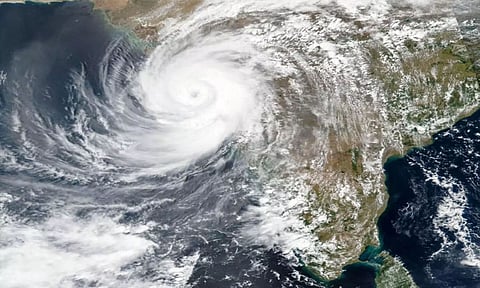
- Home
- Live Blog
- Breaking News
- Top Headlines
- Cities
- NE News
- Sentinel Media
- Sports
- Education
- Jobs

In less than a fortnight, the Western and Eastern Coasts of India have been hit by two cyclones. On May 14, it was cyclone Tauktae hit the western coast of the country causing extensive damage to areas in Maharashtra, Gujarat, and Kerala and left at least 100 dead. On May 26, severe cyclonic storm Yaas made landfall near Dhamra and Balasore in North Odisha on the east coast. It has just been a few hours after Yaas made landfall and there are still no reports of any casualties. Teams of the National Disaster Relief Fund (NDRF) and Army have already begun the relief and rescue operation as several villages and low-lying areas have been inundated. Lakhs of people were already evacuated from the coastal regions of Odisha and West Bengal. This is expected to keep lives safe. Yaas hit with a 130-140 per km wind speed. By Thursday, May 27 it is expected to move towards Bihar and Jharkhand. Heavy to very heavy rainfall has been predicted in the northeastern states of Assam and Meghalaya and in Sikkim, Bihar, Jharkhand, and eastern parts of Uttar Pradesh as Yaas moves north from Odisha and West Bengal.
This year, Yaas and Tauktae and last year it was cyclone Amphan that had devasted India's West Bengal and Odisha. Now let us take a look at where do these cyclones get their names from. Who names cyclones and why do they have the names they have.
The World Meteorological Organisation (WMO) maintains rotating lists of names that are appropriate for each tropical cyclone basin. Names of cyclones in the northern Indian Ocean-Bay of Bengal-Arabian Sea region are decided by the WMO and the United Nation's Economic and Social Commission for Asia and the Pacific (ESCAP) panel on tropical cyclones.
The 13 member countries of the ESCAP panel are –
• India
• Bangladesh
• Myanmar
• Pakistan
• The Maldives
• Oman
• Sri Lanka
• Thailand
• Iran
• Qatar
• Saudi Arabia
• United Arab Emirates
• Yemen
It is said that in alphabetical order, each country gets to pick a name for the next cyclonic system to form in the region. After Myanmar's Tauktae, the next name on the list was Oman's 'Yaas,' which is a Persian word, meaning Jasmin, a fragrant flower. Quite an unlikely name for a storm!
The names of cyclones to come are decided well in advance. There is an approved list of names already for over-150 cyclonic storms to form in the region.
Cyclones that form in every ocean basin across the world are named by the regional specialised meteorological centres (RSMCs) and Tropical Cyclone Warning Centres (TCWCs). There are six RSMCs in the world, including the India Meteorological Department (IMD), and five TCWCs.
As an RSMC, the IMD names the cyclones developing over the north Indian Ocean, including the Bay of Bengal and the Arabian Sea, after following a standard procedure. The IMD is also mandated to issue advisories to 12 other countries in the region on the development of cyclones and storms.
According to the reports, the cyclonic system that will form after 'Yaas' will be named 'Gulab,' a name chosen by Pakistan, and the one after that 'Shaheen,' by Qatar.
According to research, adopting names for cyclones makes it easier for people to remember, as opposed to numbers and technical terms. It also helps the scientific community, the media, disaster managers etc. apart from the general public. It is easy to identify individual cyclones with a name, which create awareness of their development, rapidly disseminate warnings to increased community preparedness and remove confusion where there are multiple cyclonic systems over a region.
While deciding names for cyclones, here are some of the rules that countries need to follow.
If these guidelines are followed, the name is accepted by the panel on tropical cyclones (PTC) that finalises the selection:
• The proposed name should be neutral to (a) politics and political figures (b) religious believes, (c) cultures and (d) gender.
• Name should be chosen in such a way that it does not hurt the sentiments of any group of population over the globe.
• It should not be very rude and cruel in nature.
• It should be short, easy to pronounce and should not be offensive to any member.
• The maximum length of the name will be eight letters.
• The proposed name should be provided with its pronunciation and voice over.
• The names of tropical cyclones over the north Indian Ocean will not be repeated. Once used, it will cease to be used again. Thus, the name should be new.
India has named 13 cyclones. Here is the list:
• Gati
• Tej
• Murasu
• Aag
• Vyom
• Jhar
• Probaho
• Neer
• Prabhanjan
• Ghurni
• Ambud
• Jaladhi
• Vega
An IMD committee is formed to finalise the names before sending them to the PTC.
Also Watch: